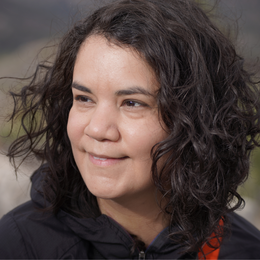There’s more (and less) to birding than you think.
When I joined the Audubon team in 2018, I brought an appreciation for birds but wouldn’t have called myself a birder. That changed when I learned just how inclusive birding can be! It’s an activity that is adaptable and accessible to people of all abilities, at any age, anywhere in the world. You see, I have what’s called “reverse-slope” hearing loss. This means it is easier for me to hear higher frequency sounds (like birds singing!) compared to lower frequency sounds (like deep voices or bass music). Though I am thankful to still have some residual hearing left, my hearing loss is on a progressive decline and I have lost almost all hearing ability in my right ear. In spite of that, I’ve embraced my abilities where they are and have learned some of the tools and tricks of the trade to enhance my birding experience.
Here are a few of my favorite accessible ways to bird:
-
Group Birding: I love solo walks in nature and going at my own pace (you might catch me at Papago Park or one of the South Mountain trails in Phoenix, Arizona on the weekends!) but I also love birding with friends, colleagues, and experts. Having additional sets of eyes helps me catch more birds. I enjoy asking questions and learning from passionate people who are always so eager to answer. As someone who is also fluent in American Sign Language, it’s also a good opportunity for me to teach a few basic signs to those willing to learn.
-
Use Mnemonic Phrases: Sometimes it's hard to remember which bird belongs to what call. A memory-aid hack called a mnemonic phrase is often used by birders to help recall bird sounds. The American Robin, for example, has a call reminiscent of “cheer-up, cheerily, cheer-up, cheerily.” For me, learning these phrases also helps describe what a bird might sound like (just like how closed captioning works), even if I do not catch it in real-time. Audubon’s online Guide to North American Birds includes bird call descriptions for each species in a section called “Songs and Calls” nestled under “Range and Identification."
- Visual Cues: As I don’t rely on my hearing to identify birds, I typically observe bird behaviors such as flight patterns to make educated guesses on what species I see. I look at whether a bird flies in a manner that is slow and consistent (soaring), or erratic like a rollercoaster (also known as an “undulating” flight pattern). I also pay attention to the silhouette and size of the bird, physical traits that are helpful for narrowing down my guesses. My favorite way to memorize bird silhouettes is spending time with a bird guide book while sketching with colored pencils or painting with watercolors! (see photo example)
- Technology: The Merlin Bird ID app, created by CornellLab, will level up your birding. The app offers a “Sound ID” feature and it has been a lifesaver for me when it comes to identifying birds by sound. The app listens for bird sounds and then offers suggestions for what species might be in your environment. I have even witnessed expert birders use the app to double-confirm their suspected IDs, especially when they cannot get a good visual of the bird but can still hear it - and they say it is pretty on-point!
These are just some of the helpful tools you can use to bird, from the perspective of a Deaf/hard of hearing person. To customize your birding experience to suit your own needs, I highly recommend checking out the Birdability website for more information and resources, as well as learn about the different experiences of birding with a disability(s).
Now is the perfect time to get into birding, if you haven’t already because spring migration is upon us! This spring, I’m keeping an eye out to spot the fleeting Western Tanager, which typically breed in higher-elevation forests but travel through urban areas during the migration seasons. Last year, many Western Tanagers were observed migrating throughout Arizona during eBird’s Global Big Day, an international spring migration count event. This year’s event will take place on May 10. Everyone is welcome to join in by birding and recording their observations (as many bird species as they can find in one day). These efforts are crucial, contributing to much needed community science and bird conservation research.
I hope this short guide will encourage more participation and will empower those with disabilities – whether visible or invisible – to build their own birding toolkit as I have. With that said, I would also encourage non-disabled folks to think about birding from other perspectives and take the time to learn about the different adaptive methods for birding (like learning basic birding terms in American Sign Language, for example) – you’ll never know what impact you might have on someone’s life!




